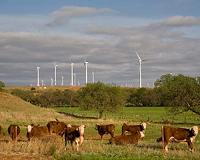 |
Boulder CO (SPX) Apr 27, 2011 While wind turbines primarily are a source of renewable energy, they also produce wakes of invisible ripples that can affect the atmosphere and influence wind turbines downstream - an issue being researched in a newly launched study led by the University of Colorado Boulder's Julie Lundquist, assistant professor in the atmospheric and oceanic sciences department. The study, called the Turbine Wake and Inflow Characterization Study, or TWICS, also includes researchers from the National Oceanic and Atmospheric Administration, the U.S. Department of Energy's National Renewable Energy Laboratory, or NREL, and the Lawrence Livermore National Laboratory in Livermore, Calif. Scientists and wind energy developers will use results of the study to better understand power production and increase the productivity of wind farms, according to the researchers. "Today's massive wind turbines stretch into a complicated part of the atmosphere," said Lundquist, who also is a joint appointee at NREL. "If we can understand how gusts and rapid changes in wind direction affect turbine operations and how turbine wakes behave, we can improve design standards, increase efficiency and reduce the cost of energy." To measure wind shifts and wake behavior, the researchers will monitor a wind turbine at NREL's National Wind Technology Center in south Boulder, using an instrument developed at NOAA called a high-resolution scanning Doppler lidar. The lidar produces three-dimensional portraits of atmospheric activity and can capture a wedge of air up to 3,280 feet from the ground and 4.3 miles long. Robert Banta, an atmospheric scientist with NOAA's Earth System Research Laboratory and a TWICS researcher, has worked with the instrument for several years. "The wake effect has been modeled in wind tunnel studies and numerical models," said Banta, "but the atmosphere is different, it's more variable and complicated." Researchers also will use a specialized laser called a Windcube lidar and a sonic detection and ranging system, called a Triton sodar, to measure wind and turbulence. In addition, NREL has installed two meteorological towers, each 135 meters tall, which will be used to measure air temperature, as well as wind and turbulence. "Even fluctuations in air temperature throughout the day can affect wind turbine wakes," said Lundquist. "The resulting changes in wake behavior can impact the productivity of wind farms with many rows of turbines, so it's important to observe them in detail and understand how to minimize their impacts." Other TWICS researchers include Yelena Pichugina, Alan Brewer, Dave Brown, Raul Alvarez and Scott Sandberg of NOAA, Neil Kelley and Andrew Clifton of NREL and Jeff Mirocha of Lawrence Livermore National Laboratory. CU-Boulder graduate students Matt Aitken, Mike Rhodes, Robert Marshall and Brian Vanderwende of Lundquist's research group also will work on the study.
Share This Article With Planet Earth
Related Links TWICS study and Lundquist Wind Energy News at Wind Daily
 Google, Japanese invest $500 million in wind farm
Google, Japanese invest $500 million in wind farmWashington (AFP) April 18, 2011 Google and the subsidiaries of two Japanese companies are investing $500 million in a wind farm being built in the northwestern US state of Oregon. Google said in a blog post Monday it was investing $100 million in the Shepherds Flat Wind Farm, expected to be the largest in the world when it is completed in 2012. Google said the wind firm is intended to produce 845 megawatts of energy, e ... read more |
|
| The content herein, unless otherwise known to be public domain, are Copyright 1995-2010 - SpaceDaily. AFP and UPI Wire Stories are copyright Agence France-Presse and United Press International. ESA Portal Reports are copyright European Space Agency. All NASA sourced material is public domain. Additional copyrights may apply in whole or part to other bona fide parties. Advertising does not imply endorsement,agreement or approval of any opinions, statements or information provided by SpaceDaily on any Web page published or hosted by SpaceDaily. Privacy Statement |